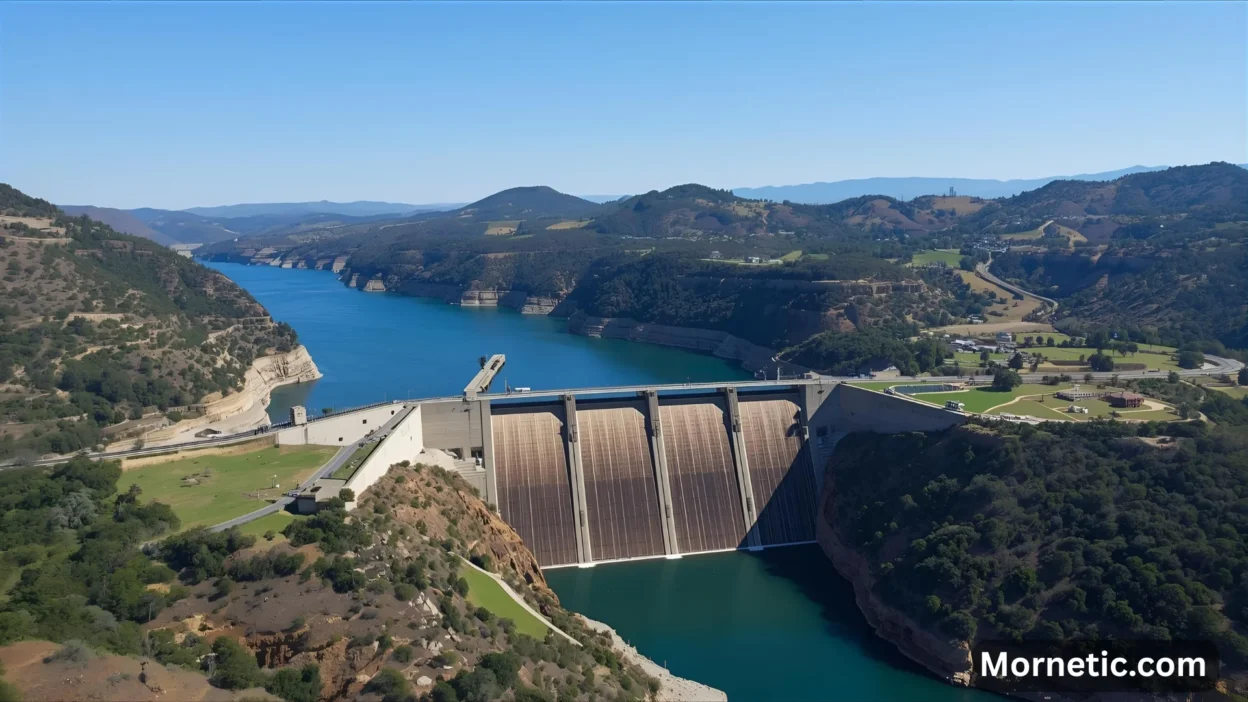In the heart of California’s wine country, a unique structure combines vital water management with mesmerizing natural spectacle. The Morning Glory Spillway at Lake Berryessa, often called the “Glory Hole,” represents the world’s largest drain of its kind. Furthermore, this brilliant engineering feat activates only during rare conditions. As of February 2025, this magnificent spillway operates at full capacity, gracefully managing water levels after atmospheric rivers deluged Northern California. Consequently, it stands as a powerful symbol of nature’s force and human ingenuity, capturing the dramatic swings between drought and deluge that characterize modern California climate patterns.
☀️ The 2025 Activation: A Timely Event
The Morning Glory Spillway operates only during absolute necessity, making each activation particularly noteworthy.
- A Dramatic Return: Following an extended dry spell, Northern California experienced a significant atmospheric river in early February 2025. Consequently, Lake Berryessa’s water surface level spiked, crossing the critical 440-foot mark and fully activating the spillway by Wednesday, February 12, 2025.
- A Fleeting Phenomenon: Although the spillway last activated in 2019 and 2017, the 2025 event demonstrates particularly dramatic flow. This contrasts sharply with extended drought conditions that kept the spillway dormant from 2006 to 2017, highlighting California’s extreme weather patterns.
- Ongoing Activity: With more storms forecast, Solano County Water Agency officials anticipate continued lake spillage for several weeks. Therefore, visitors enjoy a prolonged opportunity to witness this rare hydraulic event.
🏞️ Understanding the Morning Glory Spillway
A morning glory spillway essentially functions as an “uncontrolled” or “passive” spillway, creating a giant safety valve for reservoirs.
- The Basic Function: Technically known as a shaft spillway, it operates like a bathtub drain hole. When the lake’s water level rises beyond a specific point, water pours over the spillway’s lip and down a vertical shaft.
- A Precision Engineered Funnel: The Monticello Dam spillway features a 72-foot-wide circular lip that narrows to 28 feet at the exit. From there, water travels roughly 700 feet horizontally through a massive concrete tunnel before releasing into Putah Creek downstream.
- Impressive Capacity: When lake levels reach 15.5 feet above the spillway’s lip, this structure drains a staggering 48,400 cubic feet of water per second. That means it can fill an Olympic-sized swimming pool in seconds.
Table: Key Statistics of the Monticello Dam Morning Glory Spillway
| Feature | Measurement | Details |
|---|---|---|
| Crest Diameter | 72 feet (22 m) | The width of the circular opening at lake level. |
| Exit Diameter | 28 feet (8.5 m) | The point where the spillway narrows and water exits. |
| Maximum Flow Rate | 48,400 cu ft/s (1,370 m³/s) | The spillway’s peak drainage capacity. |
| Activation Level | 440 feet (134 m) | The lake surface elevation that triggers water flow. |
⚙️ Engineering Excellence Behind the Beauty
The Morning Glory Spillway exists because engineers faced specific geographical challenges at the dam site.
- A Solution for a Narrow Canyon: Monticello Dam construction occurred in a canyon too narrow for traditional side-channel spillways. Consequently, the morning glory design provided a compact, efficient alternative within the reservoir itself, avoiding extensive additional canyon wall construction.
- Complex Hydraulic Behavior: Designing these spillways requires accounting for multiple factors like crest diameter, spillway profile, and downstream tunnel dimensions. Moreover, hydraulic performance depends heavily on these elements, demanding meticulous study through physical models to optimize flow and prevent instability during water transition phases.
- A Global Solution: While the Lake Berryessa spillway remains the most famous, similar structures exist at Trinity Lake and Whiskeytown Lake in Northern California. Internationally, examples like Potrerillos Dam in Argentina demonstrate this clever engineering solution’s global application.
🏗️ Historical Development of an Icon
The spillway forms an integral part of Monticello Dam, a project born from regional water supply needs.
- The Solano Project: Authorities authorized the dam in 1948 as part of the Solano Project to irrigate nearly 96,000 acres of prime agricultural land. Previously, farming suffered from unreliable summer water supplies.
- A Valley Transformed: Construction began in 1953 and finished in 1957. Subsequently, rising waters from newly formed Lake Berryessa completely inundated Monticello town and Berryessa Valley, which had housed approximately 250 residents. Today, the town’s foundations remain visible during extreme low water levels.
- Reservoir Completion: The reservoir required five years to fill, finally reaching capacity on April 18, 1963. At that time, Lake Berryessa ranked as California’s second-largest reservoir by volume.
⚠️ Spectacular Yet Dangerous
The mesmerizing, whirlpool-like flow of the Morning Glory Spillway conceals immense power and potential danger.
- A Fatal Attraction: In 1997, UC Davis graduate student Emily Schwalen died after the spillway pulled her in while swimming nearby. This tragic incident underscores the structure’s lethal potential.
- Strict Safety Measures: Since the spillway can activate with little warning, authorities mark the surrounding area with buoys. Officials strongly urge spectators and recreationists to maintain safe distances and exercise careful judgment.
- Responsible Viewing: The safest viewing method involves using binoculars or zoom lenses from distant vantage points. The spectacular sight of water spiraling into the giant funnel remains awe-inspiring from afar without safety risks.
Table: Spillway Activations in the 21st Century
| Year | Significance |
|---|---|
| 2005 | Last activation before 11-year drought-induced dormancy. |
| 2017 | Broke the long drought period; first spill in over a decade. |
| 2019 | A natural spill occurred on February 26. |
| 2024 | Minor event with water “just starting to splash into the drain”. |
| 2025 | Full dramatic activation after February atmospheric rivers. |
🔍 Water Management Significance
The Morning Glory Spillway serves as a critical component within a broader system providing regional water and power.
- Sustaining Agriculture and Communities: Monticello Dam created Lake Berryessa to supply agricultural water in Sacramento Valley and municipal water for Vallejo and Benicia. A 1999 contract ensures delivery of over 200,000 acre-feet of irrigation water annually.
- Power Generation: The Monticello Dam Powerplant, completed in 1983, houses three generators with 11.5 megawatts total capacity. This power primarily serves the North Bay area of San Francisco Bay Area.
- Flood Prevention: Since project completion, the dam and reservoir have prevented over $5 million in flood damages, demonstrating the spillway’s vital public safety role.
📸 Cultural Impact and Visual Appeal
Beyond practical functions, the spillway continues to capture public imagination through multiple channels.
- Social Media Sensation: Each activation triggers vibrant activity across social media platforms dedicated to the lake. Consequently, the spillway’s otherworldly appearance attracts photographers and spectators seeking to capture its unique behavior.
- Climate Change Symbol: The spillway’s sporadic activity makes it a visible climate barometer, oscillating between prolonged drought and intense atmospheric river events.
- Tourist Destination: Despite recent resort challenges, the spillway remains a key attraction drawing worldwide visitors fascinated by its unique design and powerful presence.
💡 Frequently Asked Questions (FAQ)
Q: How often does the Morning Glory Spillway activate?
A: Activation remains rare. Throughout its nearly 70-year history, the spillway has activated approximately 25 times. Recent activations occurred in 2005, 2017, 2019, and now 2025.
Q: Can you get close to the Glory Hole?
A: Absolutely not. Authorities cordon the area with buoys due to extreme danger. The powerful suction can pull in swimmers and small boats, so only view from safe distances.
Q: Is the Morning Glory Spillway the largest in the world?
A: Yes, Monticello Dam’s spillway ranks as the world’s largest morning-glory-type spillway by diameter.
Q: What happens to water entering the spillway?
A: Water travels approximately 700 feet downward through a large concrete tunnel, emptying into Putah Creek about 2,000 feet downstream from Monticello Dam.
Q: Why is it called the “Glory Hole”?
A: “Glory Hole” serves as the local nickname. Technically, it’s a morning glory spillway, named for its flower-like appearance. The term “glory hole” commonly describes large vertical openings in mining and other fields.
✨ Concluding Perspectives
The Morning Glory Spillway at Lake Berryessa represents far more than viral curiosity. It combines 20th-century engineering mastery with critical water infrastructure and stunning natural spectacle. Its 2025 activation emphasizes the delicate balance between water resources and environmental forces. As it manages floodwaters with graceful power, this functional landmark continues inspiring awe and respect for human ingenuity meeting natural forces.

Grace is a lifestyle writer from California who loves starting mornings with positivity. At Mornetic, she shares uplifting quotes and cheerful messages to brighten your day.




